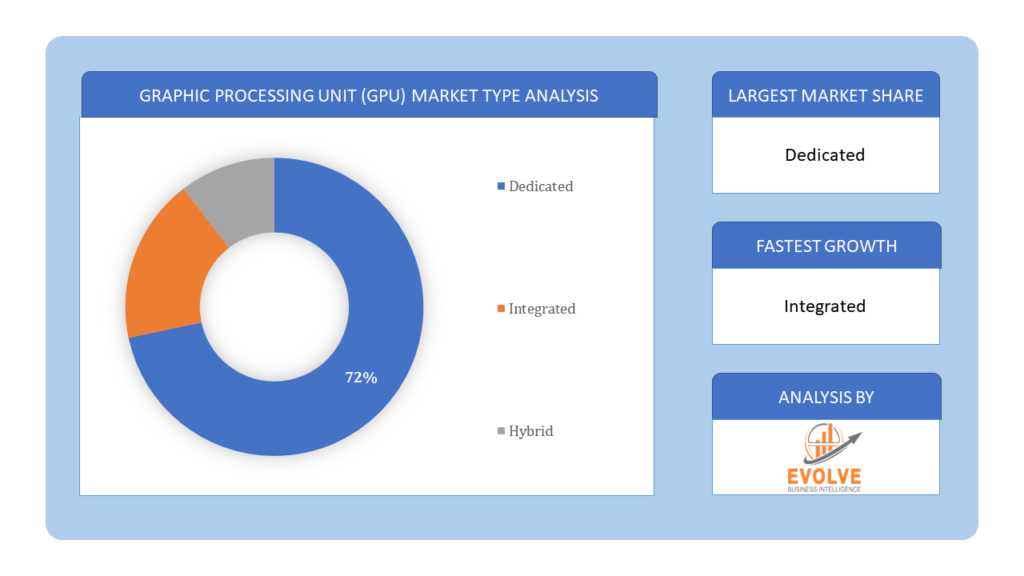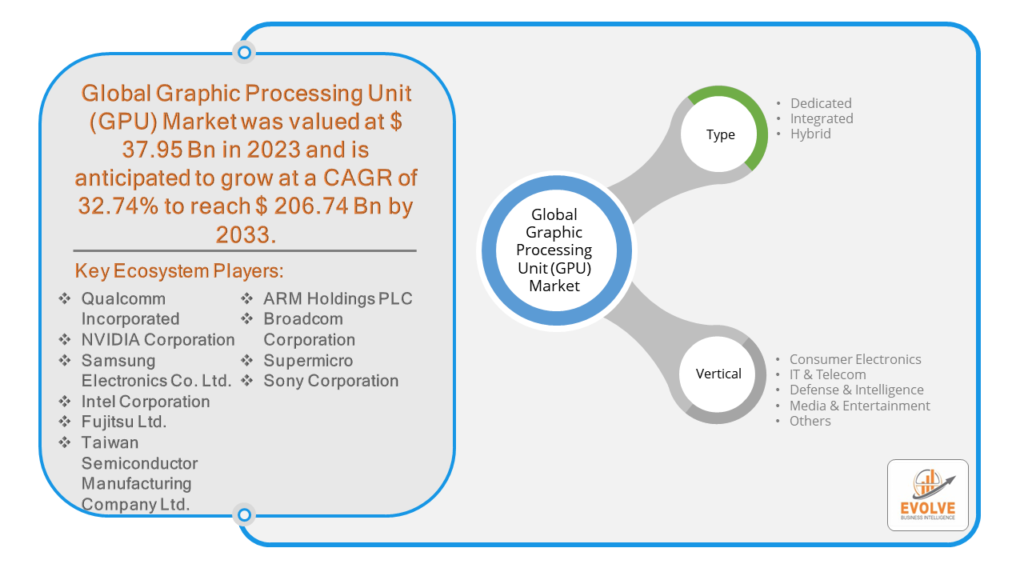Price range: $ 1,390.00 through $ 5,520.00
Graphic Processing Unit (GPU) Market Research Report: Information By Type (Dedicated, Integrated and Hybrid), By Vertical (Consumer Electronics, IT & Telecom, Defense & Intelligence, Media & Entertainment and Others), and by Region — Forecast till 2033
Description
Graphic Processing Unit (GPU) Market Overview
The Graphic Processing Unit (GPU) Market Size is expected to reach USD 206.74 Billion by 2033. The Graphic Processing Unit (GPU) Market industry size accounted for USD 37.95 Billion in 2023 and is expected to expand at a compound annual growth rate (CAGR) of 32.74% from 2023 to 2033. The Global Graphic Processing Unit (GPU) Market refers to the collective market for the production, distribution, and consumption of graphics processing units worldwide. GPUs are specialized electronic circuits designed to rapidly manipulate and alter memory to accelerate the creation of images in a frame buffer intended for output to a display device. Originally developed for rendering complex graphics in video games, GPUs have found applications in various fields including scientific simulations, cryptocurrency mining, machine learning, and artificial intelligence.
The market encompasses GPUs manufactured by various companies such as NVIDIA, AMD, Intel, and others. It includes discrete GPUs, which are standalone cards installed in computers, as well as integrated GPUs, which are embedded within CPUs. Factors influencing the global GPU market include technological advancements, demand from industries like gaming and data centers, cryptocurrency trends, and developments in emerging technologies like AI and virtual reality.
Global Graphic Processing Unit (GPU) Market Synopsis
The COVID-19 pandemic had significant impacts on the Global Graphic Processing Unit (GPU) Market. With lockdowns and restrictions forcing people to stay indoors, there has been a surge in demand for gaming and entertainment products. This increased demand for gaming PCs, consoles, and streaming services has driven up the sales of GPUs, as they are essential components for high-performance gaming experiences. The shift to remote work and online learning has led to increased demand for PCs and laptops with better graphics capabilities. Professionals and students require devices capable of handling video conferencing, multimedia content creation, and virtual collaboration tools, all of which benefit from GPUs. The pandemic disrupted global supply chains, leading to component shortages and production delays. This affected GPU manufacturers’ ability to meet the heightened demand, resulting in shortages and increased prices for certain GPU models. The pandemic accelerated trends such as cloud computing and remote data processing. As a result, there has been increased demand for GPUs in data centers and cloud services for tasks such as AI inference, deep learning, and scientific simulations.
Graphic Processing Unit (GPU) Market Dynamics
The major factors that have impacted the growth of Graphic Processing Unit (GPU) Market are as follows:
Drivers:
Ø Gaming Industry Growth
The gaming industry continues to expand, driven by the popularity of esports, mobile gaming, and virtual reality. As games become more graphically demanding, there is a constant demand for high-performance GPUs to deliver immersive gaming experiences. GPUs play a crucial role in accelerating AI and machine learning workloads, including training and inference tasks. As organizations across various sectors adopt AI technologies for automation, data analysis, and decision-making, there is a growing demand for GPUs optimized for AI workloads. Ongoing innovations in GPU architecture, such as ray tracing, tensor cores, and advanced memory technologies, drive performance improvements and fuel demand for next-generation GPUs.
Restraint:
- Perception of Production Capacity Constraints
GPU manufacturers may face challenges in scaling up production capacity to meet increasing demand, especially during periods of high demand spikes or component shortages. Limited production capacity can lead to supply constraints and longer lead times for customers. As GPU architectures become more complex and manufacturing processes advance, production costs may increase. This can lead to higher prices for GPUs, limiting their accessibility to certain market segments or slowing down the rate of adoption, particularly in price-sensitive markets. Developing advanced GPU architectures and manufacturing processes involves significant R&D investments and technical expertise. Companies face challenges in keeping pace with rapid technological advancements, meeting performance targets, and overcoming design complexities while ensuring cost-effectiveness and energy efficiency.
Opportunity:
⮚ Growing demand for AI and Machine Learning
The increasing adoption of AI and machine learning technologies across industries presents a significant growth opportunity for GPU manufacturers. GPUs are well-suited for accelerating AI workloads, including training deep learning models and performing real-time inference tasks. As organizations invest in AI-driven applications for automation, predictive analytics, and personalized services, there is a growing demand for high-performance GPUs optimized for AI processing. In the healthcare sector, GPUs are increasingly being used for medical imaging, diagnosis, and drug discovery applications. GPU-accelerated computing enables faster image reconstruction, analysis, and visualization in medical imaging modalities such as MRI, CT, and PET. GPU manufacturers can collaborate with healthcare providers, imaging equipment manufacturers, and software developers to develop GPU-based solutions for medical imaging, personalized medicine, and healthcare analytics.
Graphic Processing Unit (GPU) Market Segment Overview
By Type
 Based on Type, the market is segmented based on Dedicated, Integrated and Hybrid. The integrated segment dominated the global graphic processing unit market, as integrated GPUs find wide usage in portable electronic devices such as smartphones, tablets, wearables, laptops, and many more.
Based on Type, the market is segmented based on Dedicated, Integrated and Hybrid. The integrated segment dominated the global graphic processing unit market, as integrated GPUs find wide usage in portable electronic devices such as smartphones, tablets, wearables, laptops, and many more.
By Vertical
Based on Vertical, the market segment has been divided into the Consumer Electronics, IT & Telecom, Defense & Intelligence, Media & Entertainment and Others. The Others segment is dominant the market. Educational institutions, research organizations, and laboratories use GPUs for scientific simulations, computational modeling, and data analysis. GPUs accelerate complex calculations and simulations in fields such as physics, chemistry, biology, and climate science, enabling researchers to solve problems more efficiently and explore new scientific frontiers.
Global Graphic Processing Unit (GPU) Market Regional Analysis
Based on region, the global Graphic Processing Unit (GPU) Market has been divided into North America, Europe, Asia-Pacific, the Middle East & Africa, and Latin America. North America is projected to dominate the use of the Graphic Processing Unit (GPU) Market followed by the Asia-Pacific and Europe regions.
Graphic Processing Unit North America Market
North America holds a dominant position in the Graphic Processing Unit (GPU) Market. North America is a significant market for GPUs, driven by the presence of major GPU manufacturers, technology companies, and a large consumer base. The region leads in gaming, AI research, data centers, and HPC applications, contributing to the demand for high-performance GPUs. Additionally, North America is at the forefront of emerging technologies such as autonomous vehicles, edge computing, and healthcare innovation, creating opportunities for GPU vendors.
Graphic Processing Unit Asia-Pacific Market
The Asia-Pacific region has indeed emerged as the fastest-growing market for the Graphic Processing Unit (GPU) Market industry. The Asia-Pacific region is a major growth driver for the GPU market, fueled by rapid industrialization, urbanization, and technological advancements. Countries such as China, Japan, South Korea, and India are key markets for GPUs, with strong demand from gaming enthusiasts, technology companies, and enterprises investing in AI and cloud computing. The region also benefits from the growing adoption of smartphones, IoT devices, and digital content consumption, driving demand for mobile GPUs and embedded graphics solutions.
Competitive Landscape
The global Graphic Processing Unit (GPU) Market is highly competitive, with numerous players offering a wide range of software solutions. The competitive landscape is characterized by the presence of established companies, as well as emerging startups and niche players. To increase their market position and attract a wide consumer base, the businesses are employing various strategies, such as product launches, and strategic alliances.
Prominent Players:
- Qualcomm Incorporated
- NVIDIA Corporation
- Samsung Electronics Co. Ltd.
- Intel Corporation
- Fujitsu Ltd.
- Taiwan Semiconductor Manufacturing Company Ltd.
- ARM Holdings PLC
- Broadcom Corporation
- Supermicro
- Sony Corporation
Key Development
In January 2021, Qualcomm Technologies, Inc. today introduced its next generation of digital cockpit solutions with the 4th Generation Qualcomm® Snapdragon™ Automotive Cockpit Platforms. The automotive digital cockpit is evolving to a zonal electronic/electrical (E/E) compute architecture, driven by the complexity, cost, and need for a central compute consolidation. Scope of the Report
Global Graphic Processing Unit (GPU) Market, by Type
- Dedicated
- Integrated
- Hybrid
Global Graphic Processing Unit (GPU) Market, by Vertical
- Consumer Electronics
- IT & Telecom
- Defense & Intelligence
- Media & Entertainment
- Others
Global Graphic Processing Unit (GPU) Market, by Region
- North America
- US
- Canada
- Mexico
- Europe
- UK
- Germany
- France
- Italy
- Spain
- Benelux
- Nordic
- Rest of Europe
- Asia Pacific
- China
- Japan
- South Korea
- Indonesia
- Austalia
- Malaysia
- India
- Rest of Asia Pacific
- South America
- Brazil
- Argentina
- Rest of South America
- Middle East & Africa
- Saudi Arabia
- UAE
- Egypt
- South Africa
- Rest of Middle East & Africa
| Parameters | Indicators |
|---|---|
| Market Size | 2033: $206.74 Billion |
| CAGR | 32.74% CAGR (2023-2033) |
| Base year | 2022 |
| Forecast Period | 2023-2033 |
| Historical Data | 2021 |
| Report Coverage | Revenue Forecast, Competitive Landscape, Growth Factors, and Trends |
| Key Segmentations | Type, Verticalr |
| Geographies Covered | North America, Europe, Asia-Pacific, Latin America, Middle East, Africa |
| Key Vendors | Qualcomm Incorporated, NVIDIA Corporation, Samsung Electronics Co. Ltd., Intel Corporation, Fujitsu Ltd., Taiwan Semiconductor Manufacturing Company Ltd., ARM Holdings PLC, Broadcom Corporation, Supermicro and Sony Corporation. |
| Key Market Opportunities | • Growing demand for AI and Machine Learning • Healthcare Imaging and Diagnosis |
| Key Market Drivers | • Gaming Industry Growth • Technological Advancements |
REPORT CONTENT BRIEF:
- High-level analysis of the current and future Graphic Processing Unit (GPU) Market trends and opportunities
- Detailed analysis of current market drivers, restraining factors, and opportunities in the future
- Graphic Processing Unit (GPU) Market historical market size for the year 2021, and forecast from 2023 to 2033
- Graphic Processing Unit (GPU) Market share analysis at each product level
- Competitor analysis with detailed insight into its product segment, Government & Defense strength, and strategies adopted.
- Identifies key strategies adopted including product launches and developments, mergers and acquisitions, joint ventures, collaborations, and partnerships as well as funding taken and investment done, among others.
- To identify and understand the various factors involved in the global Graphic Processing Unit (GPU) Market affected by the pandemic
- To provide a detailed insight into the major companies operating in the market. The profiling will include the Government & Defense health of the company’s past 2-3 years with segmental and regional revenue breakup, product offering, recent developments, SWOT analysis, and key strategies.
Frequently Asked Questions (FAQ)
What is the growth rate of the Graphic Processing Unit (GPU) market?
The Graphic Processing Unit (GPU) market is expected to witness remarkable growth, with a compound annual growth rate (CAGR) of 32.74% from 2023 to 2033, reaching an estimated value of USD 206.74 Billion by 2033.
Which region has the highest growth rate in the Graphic Processing Unit (GPU) market?
The Asia-Pacific region emerges as the fastest-growing market for the Graphic Processing Unit (GPU) market, driven by rapid industrialization, urbanization, and technological advancements.
Which region has the largest share of the Graphic Processing Unit (GPU) market?
North America dominates the Graphic Processing Unit (GPU) market, fueled by major GPU manufacturers, technology companies, and a large consumer base, particularly in gaming, AI research, and data centers.
Who are the key players in the Graphic Processing Unit (GPU) market?
Key players in the Graphic Processing Unit (GPU) market include Qualcomm Incorporated, NVIDIA Corporation, Samsung Electronics Co. Ltd., Intel Corporation, Fujitsu Ltd., Taiwan Semiconductor Manufacturing Company Ltd., ARM Holdings PLC, Broadcom Corporation, Supermicro, and Sony Corporation. These companies drive market growth through innovations in GPU technology catering to diverse industries like consumer electronics, IT, defense, media, and entertainment.
Do you offer Post sales support?
Yes, we offer 16 hours of analyst support to solve the queries
Do you sell particular sections of a report?
Yes, we provide regional as well as country-level reports. Other than this we also provide a sectional report. Please get in contact with our sales representatives.
Additional information
| Packages | Single User License, Enterprise License, Data Pack Excel |
|---|
Table of Content
[html_block id="5002"]


